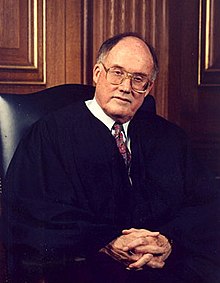
Back ዊልየም ረንኲስት Amharic ويليام رينكويست Arabic وليام رينكويست ARZ ویلیام رهنکویست AZB William Rehnquist Czech William Rehnquist Danish William H. Rehnquist German William Rehnquist English William Rehnquist Spanish ویلیام رنکویست Persian
William Rehnquist | |
|---|---|
 | |
| 16th Chief Justice of the United States | |
| In office September 25, 1986[1] – September 3, 2005 | |
| Nominated by | Ronald Reagan |
| Preceded by | Warren E. Burger |
| Succeeded by | John Roberts |
| Associate Justice of the Supreme Court of the United States | |
| In office December 15, 1971 – September 26, 1986 | |
| Nominated by | Richard Nixon |
| Preceded by | John Harlan |
| Succeeded by | Antonin Scalia |
| United States Assistant Attorney General for the Office of Legal Counsel | |
| In office January 29, 1969 – December 1971 | |
| President | Richard Nixon |
| Preceded by | Frank Wozencraft |
| Succeeded by | Ralph Erickson |
| Personal details | |
| Born | William Hubbs Rehnquist October 1, 1924 Milwaukee, Wisconsin, U.S. |
| Died | September 3, 2005 (aged 80) Arlington, Virginia, U.S. |
| Political party | Republican |
| Spouse(s) |
Nan Cornell
(m. 1953; died 1991) |
| Children | 3 |
| Education | Stanford University (BA, MA, LLB) Harvard University (MA) |
| Signature | |
| Military service | |
| Allegiance | |
| Branch/service | |
| Years of service | 1943–1946 |
| Battles/wars | World War II |
William Hubbs Rehnquist (October 1, 1924 – September 3, 2005) was an American lawyer, jurist, and a political figure. He was the 16th Chief Justice of the United States from 1986 until his death in 2005. Before becoming Chief Justice, he was an Associate Justice on the Supreme Court of the United States from 1971 to 1986.
Considered a conservative, Rehnquist favored a federalism under which the states meaningfully exercised governmental power. Under this view of federalism, the Supreme Court of the United States, for the first time since the 1930s, struck down an Act of Congress as exceeding federal power under the Commerce Clause.
Rehnquist died on September 3, 2005. He was replaced by John Roberts as Chief Justice.
- ↑ "Members of the Supreme Court of the United States". Supreme Court of the United States. Archived from the original on April 29, 2010. Retrieved April 11, 2010.
The date a Member of the Court took his/her Judicial oath (the Judiciary Act provided "That the Justices of the Supreme Court, and the district judges, before they proceed to execute the duties of their respective offices, shall take the following oath . . . ") is here used as the date of the beginning of his/her service, for until that oath is taken he/she is not vested with the prerogatives of the office.
{{cite journal}}: Cite journal requires|journal=(help)